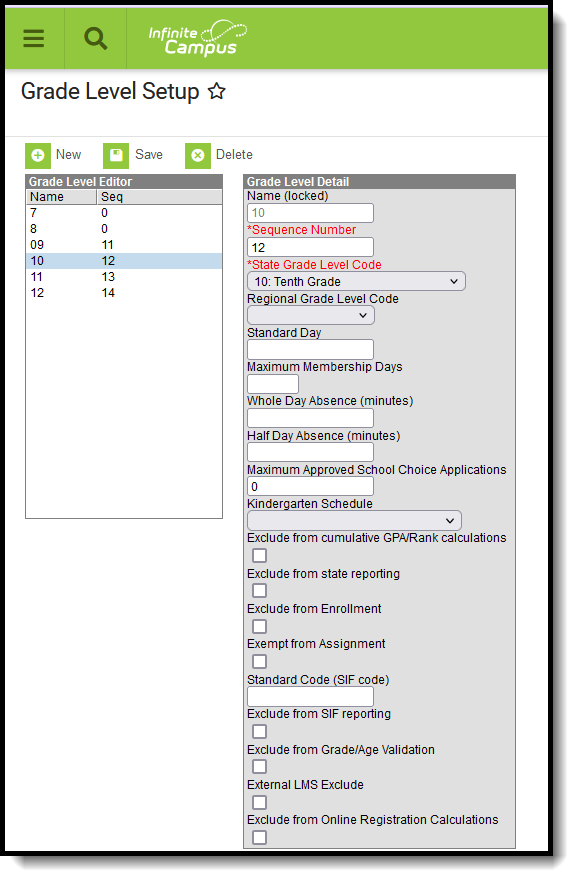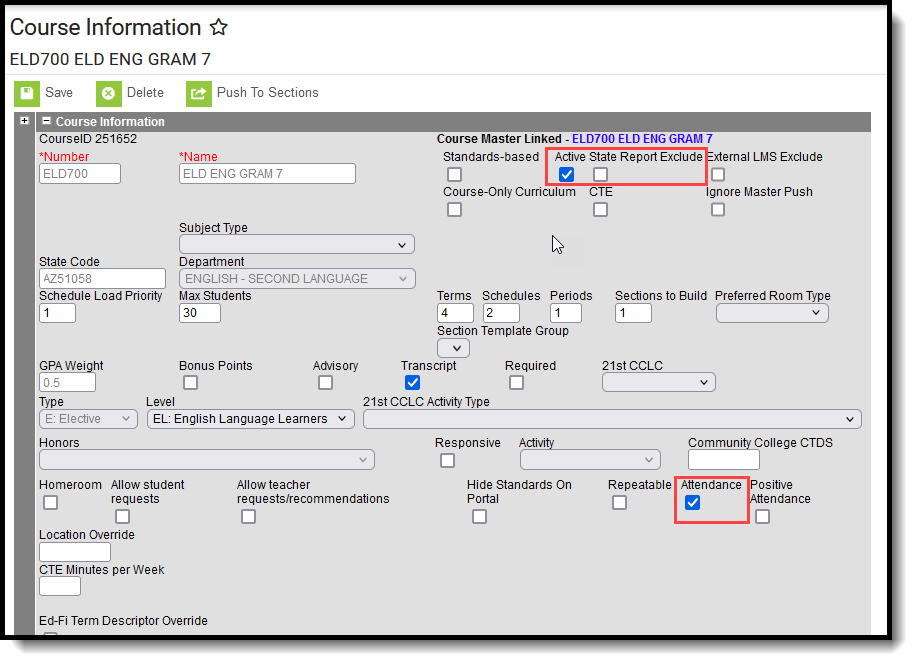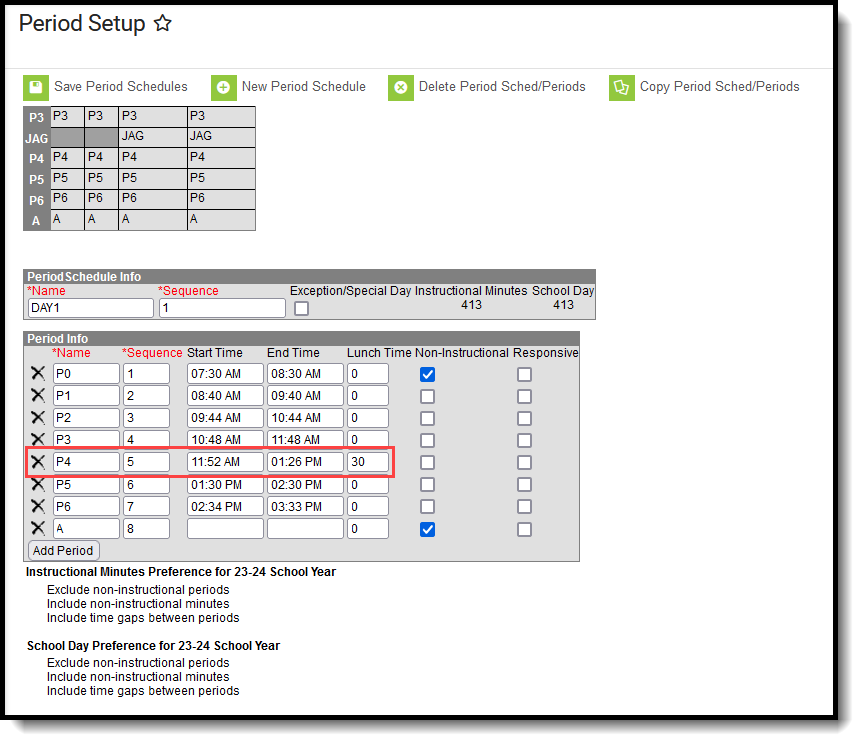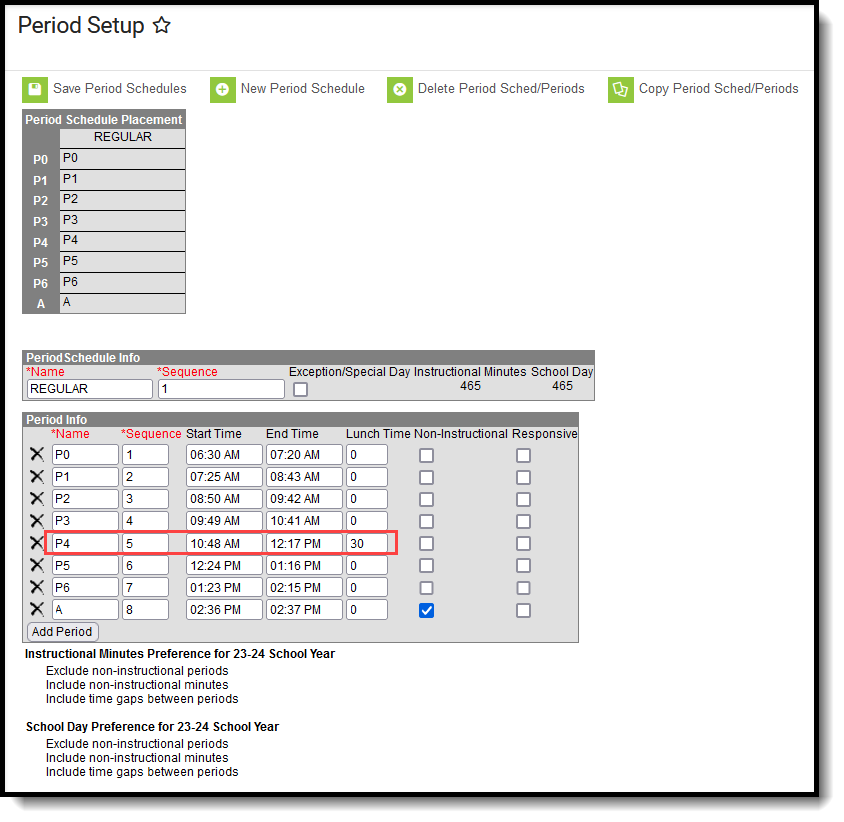Tool Search: Calendar
Within Calendar, the following tools allow users to manage calendar information:
While not all fields in these tools are specific to Arizona, some of these fields are critical to ensuring accurate reporting. These tools and fields are described below. For all other inquires, please see the appropriate article(s) linked above.
Only one Schedule Structure per calendar is allowed for Ed-Fi reporting. When there are different period schedules within a school, the district needs to create unique calendars for each schedule structure.
Be sure to use the Calendar Mapping during Ed-Fi Configuration when there are multiple calendars within a school.
Data reports in the following Ed-Fi Resources. See the Arizona Ed-Fi article for Resource details:
- Calendars
- Calendar Dates
- Student School Attendance Events
Calendar
The Calendar Information tool stores basic information about the calendar, including fields that impact how the calendar is included within state reports and Ed-Fi resources.
 Calendar Information
Calendar Information| Field | Description | Location | |||||||||
|---|---|---|---|---|---|---|---|---|---|---|---|
| Calendar ID | An automatically assigned identification number of the calendar, used for reference purposes. |
Database Location: Calendar.calendarID
Ad Hoc Inquiries: Student > School Calendar > cal.calendarID | |||||||||
| Start Date |
The start date of the calendar. This is not necessarily the first instruction day of the school year.
This field is required for saving calendar information, but it is not reported in any Ed-Fi resource.
Often, the state has requirements for what the calendar start date is for specific reports. Always follow those guidelines. Additionally, certain programs require a calendar to have a specific start date. |
Database Location: Calendar.startDate
Ad Hoc Inquiries: Student > School Calendar > cal.startDate | |||||||||
| End Date | The end date of the calendar. This is not necessarily the last instruction day of the school year.
This field is required for saving calendar information, but it is not reported in any Ed-Fi resource. |
Database Location: Calendar.endDate
Ad Hoc Inquiries: Student > School Calendar > cal.endDate | |||||||||
| Track | A numeric character indicating the track in which the student is enrolled. This field is used only for district-tracking purposes and can be left blank for districts no longer submitting calendar data for prior years. |
Database Location: Calendar.track
Ad Hoc Inquiries: Student > School Calendar > cal.track
| |||||||||
| Attendance Type | Attendance Type is typically assigned to a Calendar. This is the Attendance Type reported for ALL students assigned to the calendar.
For 21st CCLC calendars, an Attendance Type of 017: Positive is required. To assign an Attendance Type for an individual student, please see Attendance Type in the Enrollments article for more information. State reporting requires an Attendance Type. Enter this at the Calendar level or the student level when necessary.
|
Database Location: Calendar.attendanceType
Ad Hoc Inquiries: Student > School Calendar > Custom Calendar > cal.attendanceType
Student > School Calendar > cal.attendanceType
Student > Learner > State Localized Elements > es.attendanceType
Student > Learner > All Enrollments > State Localized Elements > eshist.attendanceType
Student > Learner > All Enrollments > School Calendar > histcal.attendanceType Reports: | |||||||||
| Attendance Calculation |
While this is a required field, it is typically only used for attendance calculations in grades 1-8. The option selected in this field determines how attendance data is sent to the state.
For CTE Reporting, use the QD: Quarter Day option.
|
Database Location: Calendar.attendanceCalculation
Ad Hoc Inquiries: Student > School Calendar > Custom Calendar > customCalendar. attendanceCalculation | |||||||||
| Certified in AzEDS | When marked, indicates the calendar has been certified in the AzEDS Portal. |
Database Location: Calendar.certifiedInAzEDS
Ad Hoc Inquiries: Student > School Calendar > Custom Calendar > customCalendar. certifiedInAzEDS | |||||||||
| Days Per Week |
This field indicates the number of days per week the student attends school for the given calendar.
In order for a calendar to report, this field MUST be populated. When the field is left blank, the calendar DOES NOT report.
|
Database Location: Calendar.daysPerWeek
Ad Hoc Inquiries: Student > School Calendar > Custom Calendar > customCalendar. daysPerWeek | |||||||||
| Ed-Fi Calendar ID |
When a new Calendar submission window is opened mid-year, the EdFi Calendar Code must be provided to AZeds. This value is a combination of the following fields:
This is a calculated value based on the above IDs and displays when the Calendar Information tool renders. |
Database Location: Data not stored
Ad Hoc Inquires: Not applicable |
Grade Levels
The Grade Levels tool lists the grades that attend the selected school. Only students in the listed grades can be enrolled into that calendar. Fields that are specific to the state of Arizona are defined below. Specific information to help clarify how certain fields affect reporting are also found below. Please see the Grade Levels article for all other inquiries.
 Grade Level Setup
Grade Level Setup
| Field | Description | Location |
|---|---|---|
| State Grade Level Code | The Grade Level Code indicates the current grade level of the student. |
Database Location: GradeLevel.stateGrade
Ad Hoc Inquiries: Student > Demographics > student.stateGrade
Student > Learner > Active Enrollment > Core elements > Grade Level elements > activeGradeLevel.stateGrade
Student > Learner > All Enrollments > Core elements > Grade Level elements > histGradeLevel.stateGrade |
| Kindergarten Schedule |
Indicates the format of the kindergarten classes. This must be populated for Kindergarten grade levels.
The Attendance Calculation uses this field to determine whether attendance for this grade level is whole day or half day. When multiple options are offered in the district, multiple kindergarten grade levels must be created for each kindergarten schedule offered.
See the Kindergarten Schedule table for a list of available options. |
Database Location: GradeLevel.kindergartenCode
Ad Hoc Inquiries: Student > Learner > Active Enrollment > Core Elements > Grade Level Elements > activeGradeLevel.kindergartenCode
Student > Learner > All Enrollments > Core Elements > Grade Level Elements > hist.GradeLevel.kindergartenCode |
Kindergarten Schedule
| Code | Description | Information |
|---|---|---|
| A | Half Day Every Day | Students attend school for either the AM or PM (but not both) portion of the day Monday through Friday. |
| B | Full Day Every Other Day | Students attend school for the full school day on an every other day rotation. One week the students may meet Mondays, Wednesdays, Fridays, and the following week the students may meet Tuesdays and Thursdays. |
| C | Full Day 3 Days a Week | Students attend school for the full school day for three days a week, usually Mondays, Wednesdays and Fridays. |
| D | Full Day Every Day Spring Only | Students attend school for the full school day every day during the spring semester. |
| E | Full Day Every Day | Students attend school for the full school day every day all year long. |
| F | Full Day Every Day Title 1 | Students attend school for the full school day every day all year long for Title 1 purposes. |
Schedule Structure
Schedule Structures provide a means of allowing different groups of students (by grade level, by different terms, by different day layout) to have a unique layout for their learning day.
This tool does not have any fields that are specific to the state of Arizona. Please see the Schedule Structure article for more information.
Terms
Calendar Terms list the type of calendar structure the school has - trimesters, quarters, etc. Also available are the start and end dates of the terms.
This tool does not have any fields that are specific to the state of Arizona. Please see the Terms article for more information.
Periods
Periods list the names and the times of the periods meeting throughout a school day. The editor displays the period information based on the school selected in the Campus toolbar. At least one period schedule needs to exist in a calendar. Once a period schedule exists, periods can be assigned to that schedule. Then, Calendar Days can be established and assigned a period schedule (day rotation).
This tool does not have any fields that are specific to the state of Arizona. Please see the Periods article for more information. However, there is logic associated with Period Schedules and Lunch Minute calculations that affect how attendance is calculated.
Grades K-8 Period Setup and Lunch Minutes
Grades 9-12 Period Setup and Lunch Minutes
Days
The Days tool provides a calendar type of view for all of the days in the school calendar, determined by the year, school and calendar selected in the Campus toolbar. It also displays which Period Schedules are assigned to a particular day, when any special events are assigned to a day, or when a particular day is not recording attendance, is not an instruction day, or is not a school day.
This tool does not have any fields that are specific to the state of Arizona. However, there is logic for reporting days a certain way on the Calendar Dates Resource.
- Only one Calendar Event Descriptor reports per day.
- Days can be set manually or by using the Day Reset tool.
- Day Events can be set either manually or by the Multi Day Event Wizard.
- Instructional Days report based on the Instruction checkbox on each date; all other events report from the Day Events values.
- For Calendar Events, when a date previously had a record due to the Instructional checkbox being marked, and a subsequent Day Event that is mapped to an Ed-Fi Code is added to a day, the original Instructional day record is removed from the day, leaving only the Day Event(s) records.
- For Calendar Events, when a Saturday or Sunday previously had a record in the array due to a Day Event, and all Day Events are removed, Weekend Day reports for the calendarEventDescriptor.
- For Calendar Events, a Put is completed when there is more than one event on a day and one of those events is updated.
Overrides
Calendar overrides apply to the programs a school offers to students. Overrides may be set for a person or on a household address. Person overrides take precedence over the household address override. A student may be denied enrollment to a school if the student does not live at an address within the school boundary. In this case, the student would need to obtain a person override to attend the school based on a specific curriculum program or administrative decision.
This tool does not have any fields that are specific to the state of Arizona. Please see the Overrides article for more information.
Calendar GPA
Calendar GPA lists all available Custom GPA Calculation (name and type) that may be chosen for use within that calendar. They are ordered by the sequence entered for that calculation on the GPA Calculation tool.
This tool does not have any fields that are specific to the state of Arizona. Please see the Calendar GPA article for more information.




